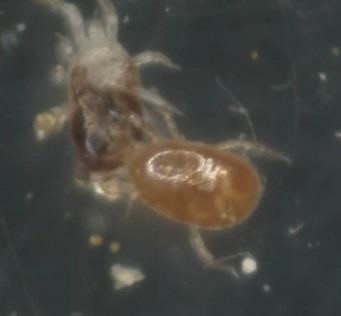
Red mite (Dermanyssus gallinae), a blood sucking mite, is a particular problem during the warmer months, generally between March and October. The mite causes chickens terrible irritation and stress. Owners may notice their birds are reluctant to perch or go into the coop at night or that birds appear rather lethargic in demeanour or pale in the comb. Health threats with severe infestations from red mites are common with anaemia (loss of red blood cells) which can, in some cases, lead to death. Red mite is a challenge to manage, so understanding its life cycle and having a treatment strategy will improve your success in keeping numbers low or eradicating them from the chicken coop.
Red mites live and breed in cracks and crevices within the house. Being sensitive to light, the adult and nymph stages emerge only at night to suck blood from the birds, then retreat to hide during the day. They are able to survive and reproduce in an impressively broad range of environmental conditions. The ideal conditions being 25-35°C and humidity greater than 70%, this will allow the mite life cycle to be only 5-8 days, which can then result in the mite numbers doubling every week. Red mites are easy to find if you go to the hen house at night, run your hand around the perch and then shine a torch on to your hand. You will see mites crawling on your hand or small blood streaks where you have squashed red mites which have just fed on your chicken’s blood. Rubbing a piece of white paper around the perch also gives you an idea if red mites are present in your coop. You can therefore see how important preventative action can be to avoid risk of red mite infestations affecting your flock. They are far easier to deter than they are to get rid of once established.
Red mites will easily survive the harsh winter chill by hiding within the depths of the chicken house. Red mites lay dormant during the lower temperatures and are not actively breeding but do manage to survive and come back to life when the weather warms up, usually in March and April. Applying some predator mites to your coop at this time may be the answer to reducing your red mite burden to a safe level for your hens.
Androlis® mites attack and eat the chicken red mite, therefore negating the need to use chemical control methods. We have seen the predator mites in action under the microscope and are very impressed with the results! The predator mite is quite aggressive to the red mite as illustrated below.

Androlis® mites are transported in a plastic bottle with a fine mesh top to enable them to live in the bottle until they arrive in the poultry coop. These mites are found naturally in birds’ nests, so they are native to the UK and perfectly safe to use. They do not harm humans or animals as their natural diet is the red mite!
Androlis® mites live in groups just like the red mite and will only live by their food source, being in the main, the chicken red mite, otherwise they would die. Red mites only live by chickens as chicken blood is their food source. The predator mites attack the red mite and then suck the blood from their body as well as eating red mite eggs. Gruesome at the best of times but incredibly adept at killing and destroying the red mite. They are just visible to the naked eye and crawl around just like red mites do.
Androlis® can be bought online via our shop in plastic bottles which also contain sustenance for them while in transit. Each bottle holds enough predators to control an average red mite population in a coop of up to 10 hens. On arrival, you push the button on the top of the bottle to enable the mites to come out into the coop. Alternatively, the contents can be tipped into small heaps around the coop in the places where you know red mites are manifesting (nests, ends of perches).
Some customers have found trapping the bottle of predator mites to the perch also works really well, as red mites blood suck at night when the birds are perching, they will automatically come into the grip of the Androlis® on route to the hens and have a nasty end! Within the pack of predator mites is an attractant which makes the chicken red mites investigate the predator mites more closely. Androlis® will also continue to breed whilst in your coop but remember, when there are no red mites left they have no food to eat. Victims of their own success!



